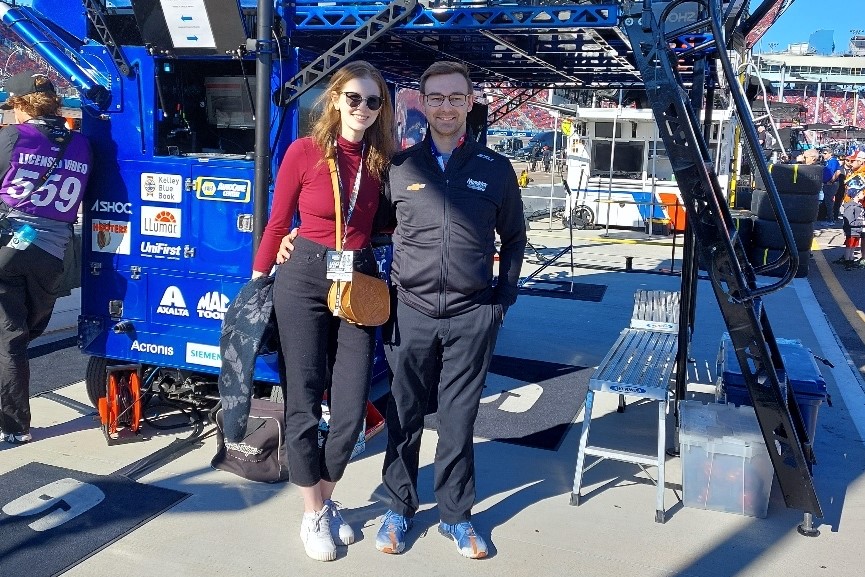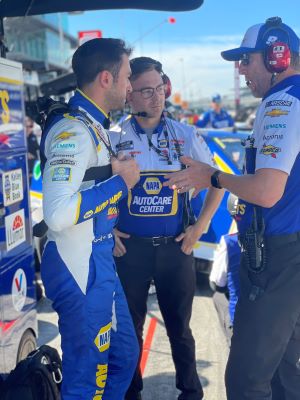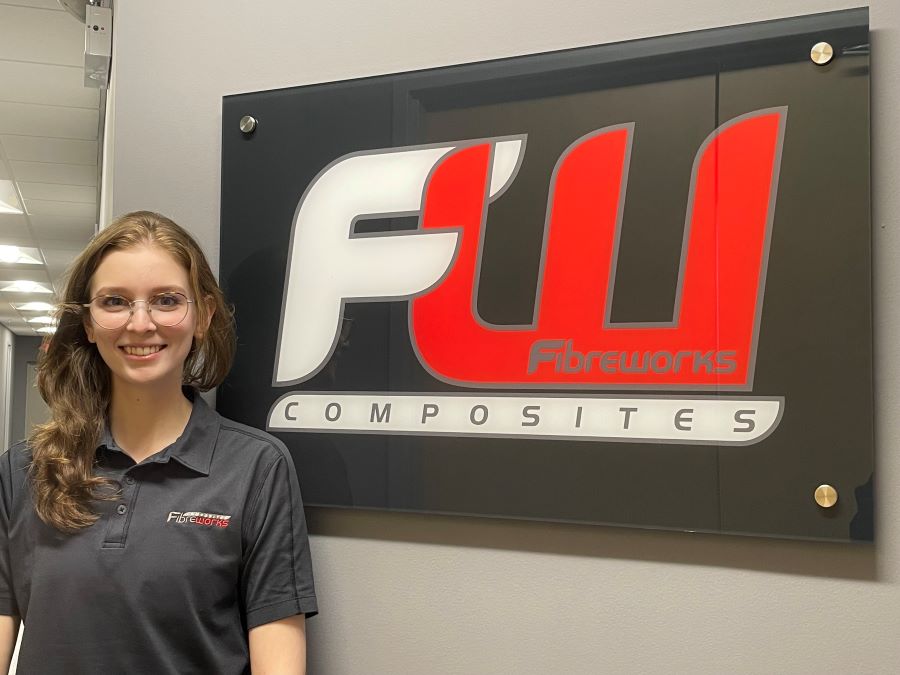
On the fast track
FROM THOROUGH MAGAZINE: Layla Bekkaoui and Andrew Hardy say being on the Huskie Formula Racing team got them on the road to careers in the racing industry.
By Scott LarsonWhen Andrew Hardy and Layla Bekkaoui were students at the University of Saskatchewan College of Engineering (USask Engineering) and working long hours on the Huskie Formula Racing team, they never dreamed they’d one day be working in the thick of the racing industry.
But today the couple is living in North Carolina and each is building their career in the motorsports world.
Hardy is a race engineer with Hendrick Motorsports, one of NASCAR’s top teams. Bekkaoui is an engineer with Fibreworks Composites, which manufactures carbon fibre motorsports parts.
“It’s an opportunity that is pretty darn phenomenal,” said Hardy of his role with Hendrick, where he works with legendary crew chief Alan Gustafson and driver Chase Elliott. “Hendrick is the top dog in the sport and has one of the greatest crew chiefs and one of the greatest drivers.”
Bekkaoui and Hardy graduated from USask Engineering in 2018 with degrees in mechanical engineering. At the college, they both decided to join the Huskie Formula Racing (HFR) team – a choice that turned out to be life-changing.

While teammates on HFR they got to know each other better and eventually became a couple. And both say being part of HFR was the catalyst that put their careers into overdrive.
“It kick-started my career,” Hardy said recently from Mooresville, NC, where he and Bekkaoui now live. “It bolstered my resume and gave me the confidence to go professional in racing.”
HFR is a student team, based in USask Engineering, that designs and builds an open-wheeled, single-seater race car and then competes at international collegiate design competitions.
When she was interviewed for a 2017 Saskatoon StarPhoenix story, Bekkaoui said she joined the team because she wanted to learn how cars work; after spending time on the team, she began thinking it would be cool to work in the racing industry. In fact, her involvement with HFR came up when she interviewed for her job.
“My first interview question at Fibreworks was, ‘Are you the guys that go ice racing?’ ”
The team makes an annual trek to Blackstrap Lake where they throw studded tires on the car and race on the lake.
The videos are popular with other students in the collegiate motorsport’s world and people at Fibreworks had seen them.
“I think without that icebreaker question, things might have gone differently for me,” Bekkaoui said. “It was one of the best decisions of my life to join that team.”
Hardy, on the other hand, has been into race cars his whole life.
“Since I was a kid, I’ve had a massive passion for motorsports. But I very quickly realized I wouldn’t be a professional race car driver myself.”
He grew up in Saskatoon and went go-karting at the track in Martensville. From there he moved up to racing stock cars at Sutherland Automotive Speedway.
Around the same time, he started his engineering courses at USask and joined the HFR team.
“It was all three things at the same time where the whole motorsport world started to click for me,” he said. “Everything came together and started to make sense.”

Hardy went down to North Carolina for a seminar on wind tunnels and developed contacts with past engineering students working in NASCAR.
That opened the door for him to get an engineering job on a team in NASCAR’s ARCA Series, where drivers develop their talents before moving into NASCAR’s higher levels.
From ARCA Hardy moved up to the Xfinity Series to be head engineer with Kaulig Racing, working with driver Ross Chastain.
“That was my first real engineering job, where I was using simulation tools, doing aerodynamics studies, parts design, and doing the car set-up every week.”
In 2021 he moved up to the NASCAR Cup Series, the highest level of competition, when he became a race engineer with Hendrick Motorsports. There he works with crew chief Gustafson and driver Chase Elliott, the Cup series champion in 2020 and a five-time winner of the most popular driver award.
When Hardy first moved to North Carolina in 2019, Bekkaoui spent a year back in Saskatoon before heading down to join him.
“That first year was difficult,” Hardy said. “I’d never moved away from home and had moved away from Layla.”
In 2019, Bekkaoui decided to join Hardy in the US. She landed the engineering design job with Fibreworks later that year.
Then the pandemic hit.
Being in the US, Hardy and Bekkaoui were isolated from family and friends. They both ended up working from home, based in their one-bedroom apartment, until they bought their first home later in 2020.
During that time, the race car teams could only send a select few people to the track.

That meant Hardy, who helped set up the car for each race, had to do all his work though simulators, analyzing data from the car without actually seeing how it performed in practice.
“We kept engineers back at the shop and set up a war room.”
During races, he would communicate with the crew chief at the track via wireless radio, explaining what changes needed to be made to the car.
In 2021, there was still no travel, but the team won a lot of races. “That was when I gained a lot of confidence,” Hardy said.
By 2022, he finally got to travel with the team, sitting in the pit box beside the crew chief, feeding him information about the car’s performance during the race.
Last June, after the team won the Ally 400 race in Nashville, Hardy made his first trip to victory lane.
“We showered each other with beer and all the confetti, it was pretty fun. I still have to pinch myself sometimes.”
It was in 2022 that NASCAR mandated a new car, called the Next Gen, which all teams must drive. NASCAR sources all the components so each team works with the same parts.
One of the suppliers is Fibreworks Composites, where Bekkaoui is part of the company’s design and manufacturing team. It’s been doing a lot of work with the floor and hood of the Next Gen cars, she said.
Besides NASCAR work, Bekkaoui has also been designing parts for the Haas F1 Team on the Formula 1 circuit.

Her work with HFR has given her a better understanding of what teams are looking for when they come to Fibreworks, she said.
And she’s also experienced what it’s like to be part of a team working toward a common goal, something that is integral to her job now.
“We all want to produce the best parts that we can. And at the end of the day, we all want to see that car drive.”
It’s heady stuff for two kids from Saskatchewan, who were married in November 2022 in Saskatoon.
Being part of HFR was the foundation for his and Bekkaoui’s careers in motorsports, said Hardy.
“It really opened up my world into learning vehicle dynamics and that is essentially what I do now.
“You are introduced into this world and if you're inquisitive enough, you’re able to get into a niche world that is difficult to get into.”
Together we will support and inspire students to succeed. We invite you to join by supporting current and future students' needs at USask.

